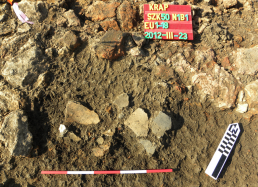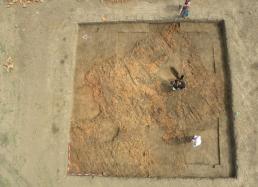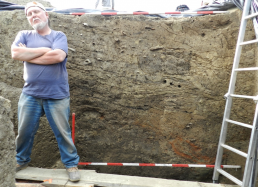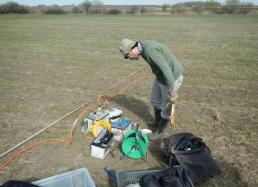2013: A New Season
This year will be the biggest and most complicated yet! Now that the team is beginning to get a grip on how this huge, complex village grew over time, they can start asking more precise questions about the different parts of the site, and also begin modeling what the the site may have looked like (see our Virtual Neolithic Village Tour for a sample.)
Unfortunately, however, this will be the last year of major field work at Szeghalom-Kovácshalom. Grant funding for the project is expiring and the team also needs to do some more work at Vésztő-Mágor, the other tell site. Plus, the tens of thousands of artifacts collected over the past three years still need to be studied—the ceramics alone number nearly 50,000 at this point!
Dr. Parkison's "to-do" list for this season includes:
- Finish excavating the longhouse in N1B1. The preservation here is astonishing, although there still many unanswered questions. For example, it's still not certain how the wood planks found on the longhouse floor were originally used in the construction of the structure. Nor is it yet known whether the longhouse was constructed with postholes or wall trenches. These seem like trivial details, but they reveal whether different longhouse clusters had different functions within the settlement. That, in turn, is important for understanding how the settlement itself was organized, and how it evolved throughout history.
- Collect samples from different parts of the settlement. Smaller test excavation units will be established across the site so that the team can compare how and when different parts of the settlement were used—the site is huge and there's always more to be discovered!
- Reopen the trench on the tell. Last year, the team extracted samples of charcoal, wood, and bone for radiocarbon dating as well as other samples for magnetic susceptibility and pollen studies. But this year, the geoarchaeologists will take samples for micro-morphological studies, which, among other things, can help determine how the different layers in the tell were formed. This kind of data will give the team more precise information about the kinds of activities that occurred on the tell, and pinpoint which were responsible for its growth over time.
- Continue to define the edges of the site using geophysics. The Greek team arrives in a couple weeks and will combine magnetometry, ground penetrating radar (GPR), multispectral satellite data, electrical resistance tomography (ERT), and other non-invasive sensing techniques to identify differences (anomalies) that reveal natural features or cultural activity hidden beneath the soil.
- Finish the paleo-environmental and paleo-hydrological studies of the Szeghalom microregion. Learning more about how the local flora and ancient riverbed changed throughout the last several thousand years will help clarify environmental factors that affected the lives of people who lived at the site and influenced their patterns of settlement throughout the millennia.
All in all, the team's long-range goal is not to only reconstruct life at Szeghalom-Kovácshalom, but also to build a better and more cross-cultural understanding of why and how prehistoric people began congregating together and establishing large settlements across Europe over time. Come follow along with Dr. Parkinson’s blogs from the field, and stay tuned to see what the team discovers during their 2013 expedition season!





